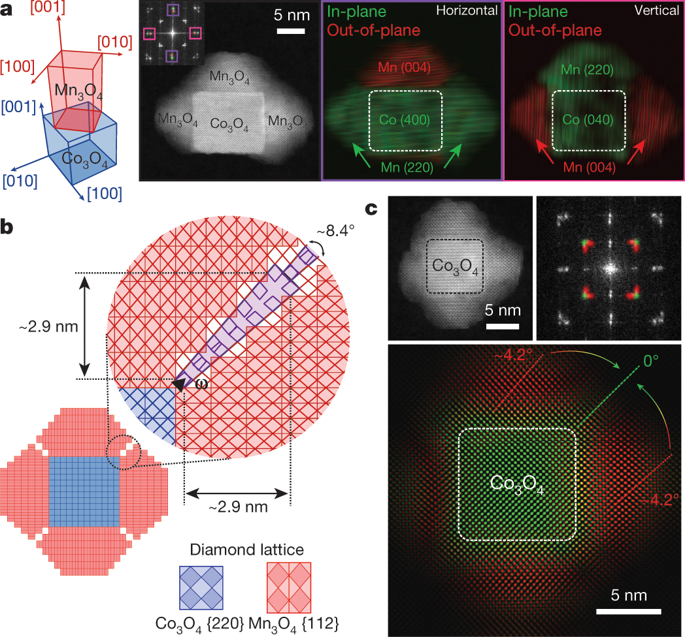Nature ( IF 64.8 ) Pub Date : 2020-01-15 , DOI: 10.1038/s41586-019-1899-3 Myoung Hwan Oh 1, 2, 3, 4, 5 , Min Gee Cho 1, 2, 5 , Dong Young Chung 1, 2 , Inchul Park 1, 6 , Youngwook Paul Kwon 7 , Colin Ophus 8 , Dokyoon Kim 1, 2, 9 , Min Gyu Kim 10 , Beomgyun Jeong 11 , X Wendy Gu 12 , Jinwoung Jo 1, 2 , Ji Mun Yoo 1, 2 , Jaeyoung Hong 1, 2 , Sara McMains 7 , Kisuk Kang 1, 6 , Yung-Eun Sung 1, 2 , A Paul Alivisatos 3, 4, 5 , Taeghwan Hyeon 1, 2

|
The impact of topological defects associated with grain boundaries (GB defects) on the electrical, optical, magnetic, mechanical and chemical properties of nanocrystalline materials1,2 is well known. However, elucidating this influence experimentally is difficult because grains typically exhibit a large range of sizes, shapes and random relative orientations3,4,5. Here we demonstrate that precise control of the heteroepitaxy of colloidal polyhedral nanocrystals enables ordered grain growth and can thereby produce material samples with uniform GB defects. We illustrate our approach with a multigrain nanocrystal comprising a Co3O4 nanocube core that carries a Mn3O4 shell on each facet. The individual shells are symmetry-related interconnected grains6, and the large geometric misfit between adjacent tetragonal Mn3O4 grains results in tilt boundaries at the sharp edges of the Co3O4 nanocube core that join via disclinations. We identify four design principles that govern the production of these highly ordered multigrain nanostructures. First, the shape of the substrate nanocrystal must guide the crystallographic orientation of the overgrowth phase7. Second, the size of the substrate must be smaller than the characteristic distance between the dislocations. Third, the incompatible symmetry between the overgrowth phase and the substrate increases the geometric misfit strain between the grains. Fourth, for GB formation under near-equilibrium conditions, the surface energy of the shell needs to be balanced by the increasing elastic energy through ligand passivation8,9,10. With these principles, we can produce a range of multigrain nanocrystals containing distinct GB defects.
中文翻译:

通过几何失配应变设计和合成多晶纳米晶体
与晶界相关的拓扑缺陷(GB 缺陷)对纳米晶材料1,2的电学、光学、磁学、机械和化学性质的影响是众所周知的。然而,通过实验阐明这种影响是困难的,因为晶粒通常表现出大范围的尺寸、形状和随机相对取向3,4,5。在这里,我们证明了对胶体多面体纳米晶体的异质外延的精确控制能够实现有序的晶粒生长,从而可以产生具有均匀 GB 缺陷的材料样品。我们用包含 Co 3 O 4纳米立方体核心的多晶粒纳米晶体来说明我们的方法,该核心带有 Mn 3 O 4每个面都有壳。各个壳是对称相关的互连晶粒6 ,相邻四方 Mn 3 O 4晶粒之间的大几何错配导致通过向错连接的 Co 3 O 4纳米立方体核的锐利边缘处的倾斜边界。我们确定了控制这些高度有序的多晶粒纳米结构生产的四个设计原则。首先,衬底纳米晶体的形状必须引导过度生长相的晶体取向7. 其次,衬底的尺寸必须小于位错之间的特征距离。第三,过度生长相和衬底之间的不相容对称性增加了晶粒之间的几何失配应变。第四,对于接近平衡条件下的 GB 形成,壳的表面能需要通过配体钝化8,9,10增加的弹性能来平衡。利用这些原理,我们可以生产出一系列包含明显 GB 缺陷的多晶纳米晶体。



























 京公网安备 11010802027423号
京公网安备 11010802027423号